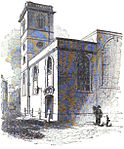Second Great Fire of London
1940 fires1940 in LondonBattle of BritainBattles and military actions in LondonBritish Empire in World War II ... and 7 more
December 1940 eventsFirebombingsFires in LondonHistory of the City of LondonThe BlitzUnited Kingdom home front during World War IIUse British English from October 2013

The Second Great Fire of London in December 1940 was caused by one of the most destructive air raids of the Blitz during World War II. The Luftwaffe raid caused fires over an area greater than that of the Great Fire of London in 1666, leading one American correspondent to say in a cable to his office that "The second Great Fire of London has begun". Fires started by the raid included an incendiary bomb that broke through the dome of St Paul's Cathedral, which was being guarded by a fire watch team at the behest of the Prime Minister Winston Churchill.
Excerpt from the Wikipedia article Second Great Fire of London (License: CC BY-SA 3.0, Authors, Images).Second Great Fire of London
Angel Lane, City of London
Geographical coordinates (GPS) Address Nearby Places Show on map
Geographical coordinates (GPS)
| Latitude | Longitude |
|---|---|
| N 51.51 ° | E -0.09 ° |
Address
Nomura International
Angel Lane 1
EC4R 3AB City of London
England, United Kingdom
Open on Google Maps










